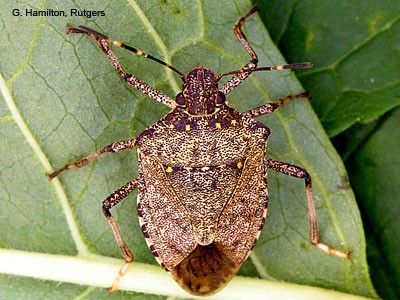|
Skunk, cilantro, burnt rubber—just a few of the many scents you might associate with the pungent odor produced by stink bugs. Like many animals, these bugs produce a variety of chemical odors (called semiochemicals) that modify the behavior of recipient organisms in different ways. That “stink” that these bugs get their name from is just one example. Stink bugs (family Pentatomidae) represent an extremely diverse family of insects that includes both agricultural pests and beneficial predators. Some of the agricultural pest species can cause millions of dollars in damages to crops. At the USDA Agricultural Research Service in Beltsville, Maryland, Dr. Don Weber studies stink bug semiochemicals in hopes of being able to take advantage of their communication to monitor their populations. In particular, Dr. Weber studies pheromones – one kind of semiochemical used for communication within a species. For example, male stink bugs emit pheromones to attract females, or in other cases, both females and males. In other insects, pheromones can also act to signal danger, food resources, or aggregation sites. Because semiochemical signals often influence insect behavior, synthetically replicating these scents equips growers with a powerful tool to manage agricultural insect pests. This strategy works most effectively if the chemical composition of the natural odor is identified and isolated, and if the behavior it elicits is fully understood. The invasive brown marmorated stink bug (BMSB) (Halyomorpha halys) and the harlequin bug (Murgantia histrionica) (Figure 1) both respond to traps baited with pheromone lures which can be used in order to monitor levels of these pests to determine whether or not to take action against them with insecticides (Figure 2). With stink bugs, there are some challenges that researchers such as Dr. Weber have faced in using pheromones as lures. Pheromones released by male stink bugs are not exclusively sex pheromones;females, males and nymphs alike are attracted by the male pheromones. This indicates to researchers that those pheromones might have some of the other roles mentioned above, such as signaling aggregation sites. Yet another piece to this complicated smell puzzle stems from cross-species attraction, meaning that the deployment of a pheromone by one stink bug species can attract another stink bug species. Scientists can monitor BMSB by using MDT, the aggregation pheromone of a completely different stink bug species (the Asian brown-winged green bug, Plautia stali). However, because the pheromone is most attractive to BMSB in the fall, which is after most crop harvests have finished or already starting, so this is not very helpful for most growers1. To produce better attractants for BMSB, researchers successfully identified the specific aggregation pheromone produced by BMSB adult males. The pheromone (commonly called murgantiol) is comprised of two different isomers, or molecular conformations, with a specific ratio. This ratio is important to know because there can be variation between species, and even between individual bugs, for what ratio is most attractive. Dr. Weber and colleagues determined which isomer ratio of murgantiol was most attractive separately to BMSB, and then combined this pheromone with MDT to see if a blend of the two was attractive to the bugs. The two pheromones together were much more attractive than either alone – with an added advantage of this blend being attractive to the bugs all season long, unlike MDT by itself. These pheromones also do not need to be extremely pure, which is good news for keeping the cost of lure production low. Harlequin bug males produce murgantiol as well – so the same types of lures can be used to monitor both pest species, though the two species have different ideal isomer ratios5. Harlequin bugs, however, specialize in feeding on cruciferous plants – unlike BMSB, which are unspecific in their preferred hosts (polyphagous). Harlequin bugs were found by Dr. Weber to also be highly attracted to pheromones mixed with mustard oils, which are chemically derived from their host plants’ defensive compounds6,7. Adding these oils to murgantiol therefore could enhance trap performance for harlequin bugs, much like MDT for BMSB. While Dr. Weber and his colleagues uncovered a lot of information about stink bug pheromones, there is still room to further our understanding. Now that researchers have evidence for which pheromone blends work most effectively for the two species, there is a lot of fine-tuning to be done about how exactly to use them in traps, and the most economical way to produce them. Dr. Weber and his colleagues also have plans in the works to investigate using pheromones for other pest-combating purposes, such as attracting insect predators of pest species like stink bugs, and genetically engineering plants to produce insect pheromones and act as trap crops. Overall pheromones offer an exciting approach to manage not only stink bugs, but many different pest insects, to better protect our agriculture. To learn more about Dr. Weber’s research or contact him, visit his USDA homepage. For more information on BMSB or Harlequin bugs, you can visit the University of Maryland Extension pages on BMSB and Harlequin bugs. Authors: Elizabeth Brandt, Aditi Dubey, Morgan Thompson Resources Cited
Comments are closed.
|
Categories
All
Archives
June 2024
|
Department of Entomology
University of Maryland
4112 Plant Sciences Building
College Park, MD 20742-4454
USA
Telephone: 301.405.3911
Fax: 301.314.9290
University of Maryland
4112 Plant Sciences Building
College Park, MD 20742-4454
USA
Telephone: 301.405.3911
Fax: 301.314.9290




 RSS Feed
RSS Feed




